B4 unit3 Grammar v-ing作表语、定语和宾语补足语的用法
- 格式:ppt
- 大小:347.50 KB
- 文档页数:31
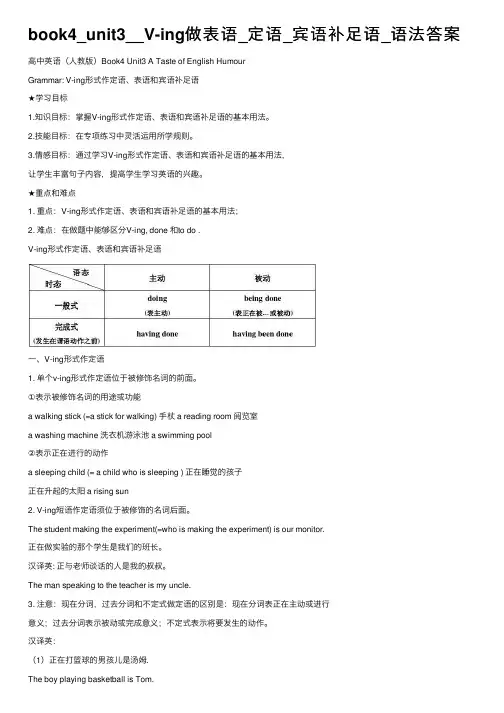
book4_unit3__V-ing做表语_定语_宾语补⾜语_语法答案⾼中英语(⼈教版)Book4 Unit3 A Taste of English HumourGrammar: V-ing形式作定语、表语和宾语补⾜语★学习⽬标1.知识⽬标:掌握V-ing形式作定语、表语和宾语补⾜语的基本⽤法。
2.技能⽬标:在专项练习中灵活运⽤所学规则。
3.情感⽬标:通过学习V-ing形式作定语、表语和宾语补⾜语的基本⽤法,让学⽣丰富句⼦内容,提⾼学⽣学习英语的兴趣。
★重点和难点1. 重点:V-ing形式作定语、表语和宾语补⾜语的基本⽤法;2. 难点:在做题中能够区分V-ing, done 和to do .V-ing形式作定语、表语和宾语补⾜语⼀、V-ing形式作定语1. 单个v-ing形式作定语位于被修饰名词的前⾯。
①表⽰被修饰名词的⽤途或功能a walking stick (=a stick for walking) ⼿杖 a reading room 阅览室a washing machine 洗⾐机游泳池 a swimming pool②表⽰正在进⾏的动作a sleeping child (= a child who is sleeping ) 正在睡觉的孩⼦正在升起的太阳 a rising sun2. V-ing短语作定语须位于被修饰的名词后⾯。
The student making the experiment(=who is making the experiment) is our monitor.正在做实验的那个学⽣是我们的班长。
汉译英: 正与⽼师谈话的⼈是我的叔叔。
The man speaking to the teacher is my uncle.3. 注意:现在分词,过去分词和不定式做定语的区别是:现在分词表正在主动或进⾏意义;过去分词表⽰被动或完成意义;不定式表⽰将要发⽣的动作。
汉译英:(2)⽤过的书used books ⼀颗倒下的树 a fallen tree(3)我很多⼯作要做。
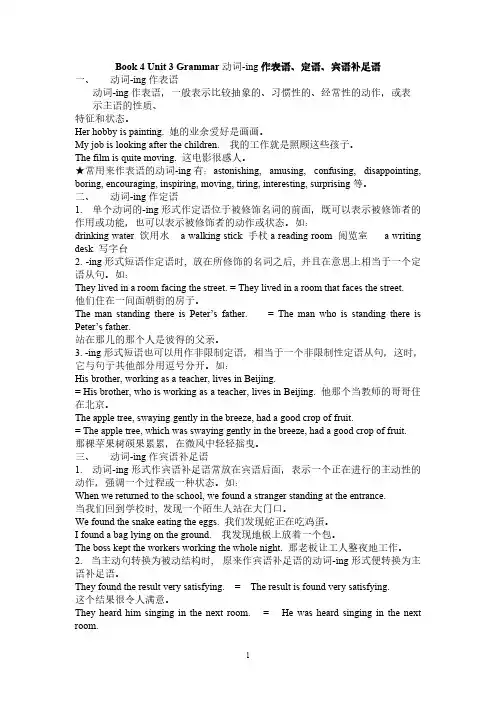
Book 4 Unit 3 Grammar动词-ing作表语、定语、宾语补足语一、动词-ing作表语动词-ing作表语,一般表示比较抽象的、习惯性的、经常性的动作,或表示主语的性质、特征和状态。
Her hobby is painting. 她的业余爱好是画画。
My job is looking after the children. 我的工作就是照顾这些孩子。
The film is quite moving. 这电影很感人。
★常用来作表语的动词-ing有:astonishing, amusing, confusing, disappointing, boring, encouraging, inspiring, moving, tiring, interesting, surprising等。
二、动词-ing作定语1. 单个动词的-ing形式作定语位于被修饰名词的前面,既可以表示被修饰者的作用或功能,也可以表示被修饰者的动作或状态。
如:drinking water 饮用水 a walking stick 手杖a reading room 阅览室 a writing desk 写字台2. -ing形式短语作定语时, 放在所修饰的名词之后, 并且在意思上相当于一个定语从句。
如:They lived in a room facing the street. = They lived in a room that faces the street.他们住在一间面朝街的房子。
The man standing there is Peter’s father. = The man who is standing there is Peter’s father.站在那儿的那个人是彼得的父亲。
3. -ing形式短语也可以用作非限制定语,相当于一个非限制性定语从句,这时,它与句子其他部分用逗号分开。
如:His brother, working as a teacher, lives in Beijing.= His brother, who is working as a teacher, lives in Beijing. 他那个当教师的哥哥住在北京。
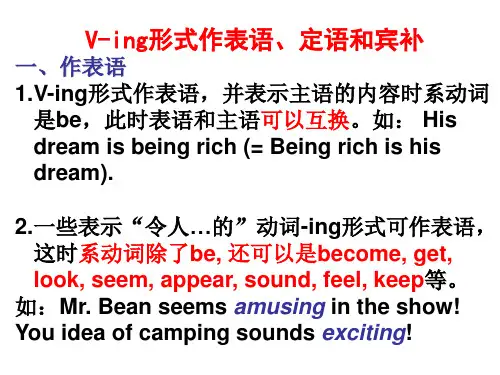
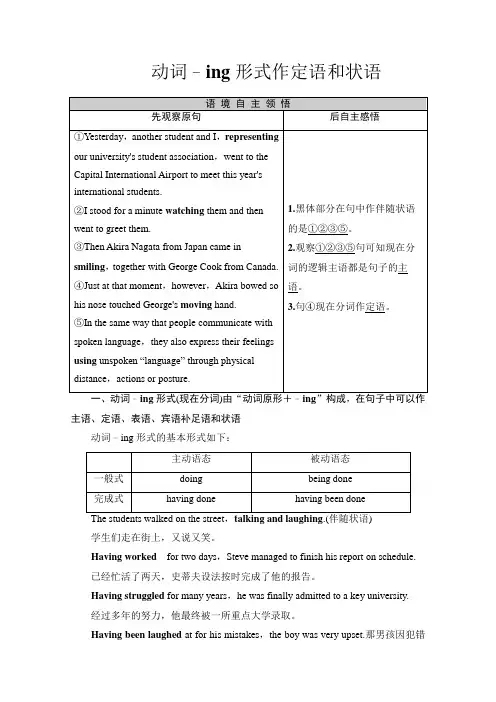
动词–ing形式作定语和状语语境自主领悟先观察原句后自主感悟①Yesterday,another student and I,representingour university's student association,went to theCapital International Airport to meet this year'sinternational students.②I stood for a minute watching them and then went to greet them.③Then Akira Nagata from Japan came in smiling,together with George Cook from Canada.④Just at that moment,however,Akira bowed so his nose touched George's moving hand.⑤In the same way that people communicate with spoken language,they also express their feelings using unspoken “language” through physical distance,actions or posture. 1.黑体部分在句中作伴随状语的是①②③⑤。
2.观察①②③⑤句可知现在分词的逻辑主语都是句子的主语。
3.句④现在分词作定语。
主语、定语、表语、宾语补足语和状语动词–ing形式的基本形式如下:主动语态被动语态一般式doing being done完成式having done having been done学生们走在街上,又说又笑。
Having worked for two days,Steve managed to finish his report on schedule.已经忙活了两天,史蒂夫设法按时完成了他的报告。

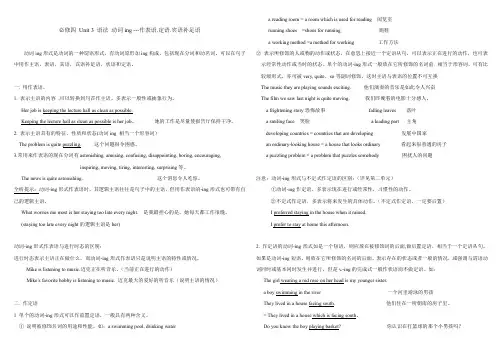
必修四Unit 3 语法动词ing ---作表语.定语.宾语补足语动词ing形式是动词的一种谓语形式,有动词原形加ing构成,包括现在分词和动名词。
可以在句子中用作主语,表语,宾语,宾语补足语,状语和定语。
一.用作表语。
1. 表示主语的内容,可以转换到句首作主语。
多表示一般性或抽象行为。
Her job is keeping the lecture hall as clean as possible.Keeping the lecture hall as clean as possible is her job。
她的工作是尽量使报告厅保持干净。
2. 表示主语具有的特征、性质和状态(动词ing 相当一个形容词)The problem is quite puzzling. 这个问题很令困惑。
3.常用来作表语的现在分词有astonishing, amusing, confusing, disappointing, boring, encouraging,inspiring, moving, tiring, interesting, surprising等。
The news is quite astonishing. 这个消息令人吃惊。
全析提示:动词-ing形式作表语时,其逻辑主语往往是句子中的主语,但用作表语的-ing形式也可带有自己的逻辑主语。
What worries me most is her staying too late every night. 是我最担心的是,她每天都工作很晚。
(staying too late every night的逻辑主语是her)动词-ing形式作表语与进行时态的区别:进行时态表示主语正在做什么,而动词-ing形式作表语只是说明主语的特性或情况。
Mike is listening to music.迈克正在听音乐。
(当前正在进行的动作)Mike’s favorite hobby is listening to music. 迈克最大的爱好的听音乐(说明主语的情况)二. 作定语1 单个的动词-ing形式可以作前置定语,一般具有两种含义。
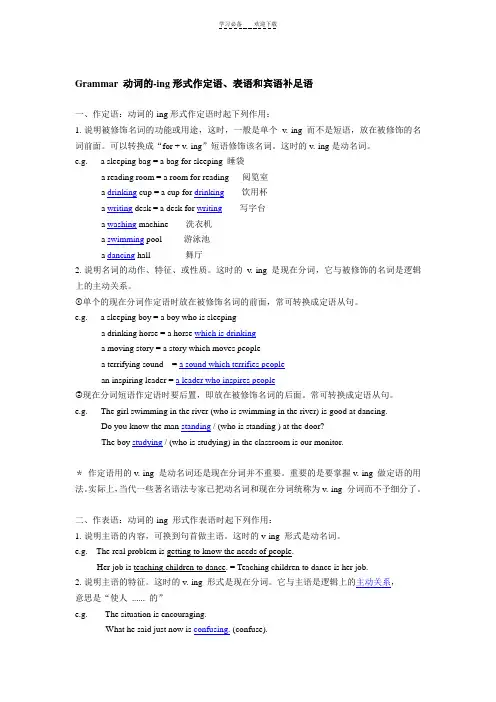
Grammar 动词的-ing形式作定语、表语和宾语补足语一、作定语:动词的-ing形式作定语时起下列作用:1.说明被修饰名词的功能或用途,这时,一般是单个v.-ing 而不是短语,放在被修饰的名词前面。
可以转换成“for + v.-ing”短语修饰该名词。
这时的v.-ing是动名词。
e.g. a sleeping bag = a bag for sleeping 睡袋a reading room = a room for reading 阅览室a drinking cup = a cup for drinking饮用杯a writing desk = a desk for writing写字台a washing machine 洗衣机a swimming pool 游泳池a dancing hall 舞厅2.说明名词的动作、特征、或性质。
这时的v.-ing 是现在分词,它与被修饰的名词是逻辑上的主动关系。
①单个的现在分词作定语时放在被修饰名词的前面,常可转换成定语从句。
e.g. a sleeping boy = a boy who is sleepinga drinking horse = a horse which is drinkinga moving story = a story which moves peoplea terrifying sound = a sound which terrifies peoplean inspiring leader = a leader who inspires people②现在分词短语作定语时要后置,即放在被修饰名词的后面。
常可转换成定语从句。
e.g. The girl swimming in the river (who is swimming in the river) is good at dancing.Do you know the man standing / (who is standing ) at the door?The boy studying / (who is studying) in the classroom is our monitor.*作定语用的v.-ing 是动名词还是现在分词并不重要。

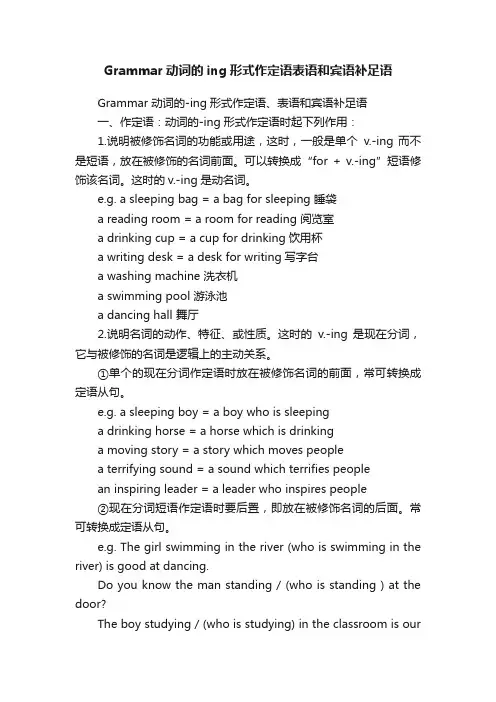
Grammar动词的ing形式作定语表语和宾语补足语Grammar 动词的-ing形式作定语、表语和宾语补足语一、作定语:动词的-ing形式作定语时起下列作用:1.说明被修饰名词的功能或用途,这时,一般是单个v.-ing 而不是短语,放在被修饰的名词前面。
可以转换成“for + v.-ing”短语修饰该名词。
这时的v.-ing是动名词。
e.g. a sleeping bag = a bag for sleeping 睡袋a reading room = a room for reading 阅览室a drinking cup = a cup for drinking饮用杯a writing desk = a desk for writing写字台a washing machine 洗衣机a swimming pool 游泳池a dancing hall 舞厅2.说明名词的动作、特征、或性质。
这时的v.-ing 是现在分词,它与被修饰的名词是逻辑上的主动关系。
①单个的现在分词作定语时放在被修饰名词的前面,常可转换成定语从句。
e.g. a sleeping boy = a boy who is sleepinga drinking horse = a horse which is drinkinga moving story = a story which moves peoplea terrifying sound = a sound which terrifies peoplean inspiring leader = a leader who inspires people②现在分词短语作定语时要后置,即放在被修饰名词的后面。
常可转换成定语从句。
e.g. The girl swimming in the river (who is swimming in the river) is good at dancing.Do you know the man standing / (who is standing ) at the door?The boy studying / (who is studying) in the classroom is ourmonitor.*作定语用的v.-ing 是动名词还是现在分词并不重要。
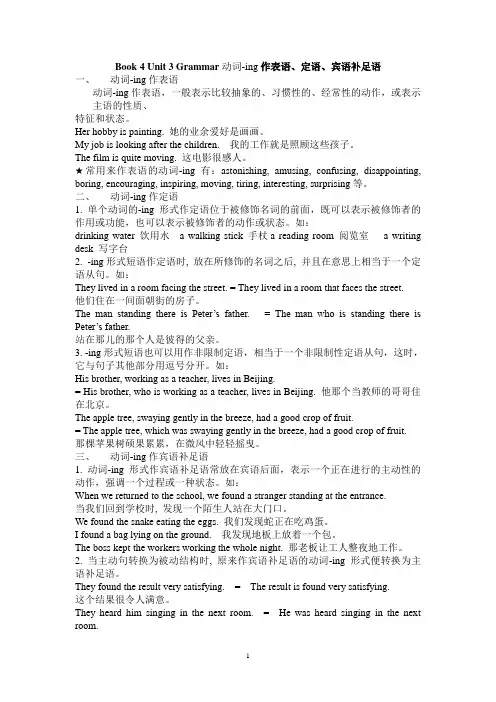
Book 4 Unit 3 Grammar动词-ing作表语、定语、宾语补足语一、动词-ing作表语动词-ing作表语,一般表示比较抽象的、习惯性的、经常性的动作,或表示主语的性质、特征和状态。
Her hobby is painting. 她的业余爱好是画画。
My job is looking after the children. 我的工作就是照顾这些孩子。
The film is quite moving. 这电影很感人。
★常用来作表语的动词-ing有:astonishing, amusing, confusing, disappointing, boring, encouraging, inspiring, moving, tiring, interesting, surprising等。
二、动词-ing作定语1. 单个动词的-ing形式作定语位于被修饰名词的前面,既可以表示被修饰者的作用或功能,也可以表示被修饰者的动作或状态。
如:drinking water 饮用水 a walking stick 手杖a reading room 阅览室 a writing desk 写字台2. -ing形式短语作定语时, 放在所修饰的名词之后, 并且在意思上相当于一个定语从句。
如:They lived in a room facing the street. = They lived in a room that faces the street.他们住在一间面朝街的房子。
The man standing there is Peter’s father. = The man who is standing there is Peter’s father.站在那儿的那个人是彼得的父亲。
3. -ing形式短语也可以用作非限制定语,相当于一个非限制性定语从句,这时,它与句子其他部分用逗号分开。
如:His brother, working as a teacher, lives in Beijing.= His brother, who is working as a teacher, lives in Beijing. 他那个当教师的哥哥住在北京。
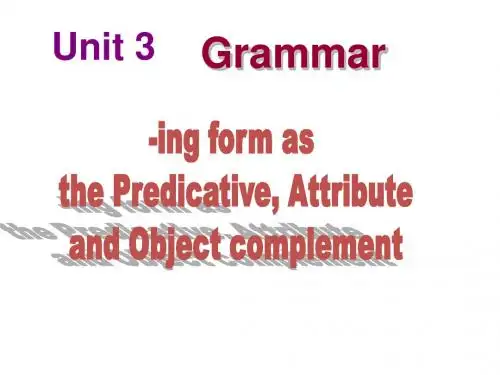
高中英语(人教版)Book4 Unit3 A Taste of English HumourGrammar: V-ing形式作定语、表语和宾语补足语★学习目标1.知识目标:掌握V-ing形式作定语、表语和宾语补足语的基本用法。
2.技能目标:在专项练习中灵活运用所学规则。
3.情感目标:通过学习V-ing形式作定语、表语和宾语补足语的基本用法,让学生丰富句子内容,提高学生学习英语的兴趣。
★重点和难点1. 重点:V-ing形式作定语、表语和宾语补足语的基本用法;2. 难点:在做题中能够区分V-ing, done 和to do .V-ing形式作定语、表语和宾语补足语一、V-ing形式作定语1. 单个v-ing形式作定语位于被修饰名词的前面。
①表示被修饰名词的用途或功能a walking stick (=a stick for walking) 手杖 a reading room 阅览室a washing machine 洗衣机游泳池 a swimming pool②表示正在进行的动作a sleeping child (= a child who is sleeping ) 正在睡觉的孩子正在升起的太阳 a rising sun2. V-ing短语作定语须位于被修饰的名词后面。
The student making the experiment(=who is making the experiment) is our monitor.正在做实验的那个学生是我们的班长。
汉译英: 正与老师谈话的人是我的叔叔。
The man speaking to the teacher is my uncle.3. 注意:现在分词,过去分词和不定式做定语的区别是:现在分词表正在主动或进行意义;过去分词表示被动或完成意义;不定式表示将要发生的动作。
汉译英:(1)正在打篮球的男孩儿是汤姆.The boy playing basketball is Tom.(2)用过的书used books 一颗倒下的树 a fallen tree(3)我很多工作要做。
ing形式做定语、状语和宾语补足语ing形式是非谓语动词形式之一,它在向中不能做谓语,但是可以做主语、宾语、表语、定语、状语和宾语补足语。
其时态和语态形式如下(以do为例):(1) v.ing的一股式所表示的动作与谓语动词所表示的动作几乎同时发生或发生在谓语动词所表示的动作之后。
I saw them chatting in the shade of a large tree.我观察他们正在一棵大树的树荫下闲聊。
〔同时〕We met a traffic accident, causing the delay.我们遇到了一起交通事故,所以晚了。
(稍后)(2) v.ing的完成式所表示的动作发生在谓语动词所表示的动作之前。
She didn't remember having met him before.她不记得以前见过他。
〔先于谓语动词所表示的动作发生〕Having been played tricks on many times, she now doesn't believe Joe.由于屡次被戏弄,她现在都不信任乔了。
〔先于谓语动词所表示的动作发生且表被动〕1.v.ing形式做定语(1)动名词(短语)做定语,表示名词的作用或用途。
“作……用〞讲,相当于一个介词for短语。
There is a swimming pool( = a pool for swimming) in ourschool. 我们学校有一个游泳池。
Students are not permitted to speak aloud in the readingroom ( = the room for reading).阅览室里不允许同学们大声喧哗。
(2)现在分词(短语)做定语,表示所修饰词的动作或状态,被修饰词与现在分词之间存在主动关系,相当于一个定语从句。
当单个的现在分词做定语时,放在被修饰词前;假设是现在分词短语做定语,那么放在被修饰词后。